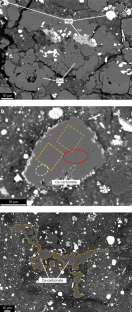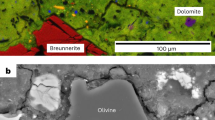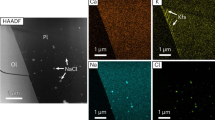Abstract
Samples from asteroid Ryugu returned by the Hayabusa2 mission contain evidence of extensive alteration by aqueous fluids and appear related to the CI chondrites. To understand the sources of the fluid and the timing of chemical reactions occurring during the alteration processes, we investigated the oxygen, carbon and 53Mn–53Cr systematics of carbonate and magnetite in two Ryugu particles. We find that the fluid was initially between 0 and 20 °C and enriched in 13C, 17O and 18O, and subsequently evolved towards lighter carbon and oxygen isotopic compositions as alteration proceeded. Carbonate ages show that this fluid–rock interaction took place within approximately the first 1.8 million years of Solar System history, requiring early accretion either in a planetesimal less than ∼20 km in diameter or within a larger body that was disrupted and reassembled.
This is a preview of subscription content, access via your institution
Access options
Access Nature and 54 other Nature Portfolio journals
Get Nature+, our best-value online-access subscription
$29.99 / 30 days
cancel any time
Subscribe to this journal
Receive 12 digital issues and online access to articles
$119.00 per year
only $9.92 per issue
Buy this article
- Purchase on Springer Link
- Instant access to full article PDF
Prices may be subject to local taxes which are calculated during checkout





Similar content being viewed by others
Data availability
Correspondence and requests for materials should be addressed to K.A.M. and N.M. All analytical data related to this manuscript will be put on the JAXA Data ARchives and Transmission System (https://www.darts.isas.jaxa.jp/curation/hayabusa2) after a 1-year proprietary period.
References
Yada, T. et al. Preliminary analysis of the Hayabusa2 samples returned from C-type asteroid Ryugu. Nat. Astron. 6, 214–220 (2022).
Pilorget, C. et al. First compositional analysis of Ryugu samples by the MicrOmega hyperspectral microscope. Nat. Astron. 6, 221–225 (2022).
Ito, M. et al. A pristine record of outer solar system materials from asteroid Ryugu’s returned sample. Nat. Astron. 6, 1163–1171 (2022).
Yokoyama, T. et al. Samples returned from the asteroid Ryugu are similar to Ivuna-type carbonaceous meteorites. Science 0, eabn7850 (2022).
Nakamura, E. et al. On the origin and evolution of the asteroid Ryugu: a comprehensive geochemical perspective. Proc. Jpn Acad. Ser. B 98, 227–282 (2022).
Greenwood, R. C. et al. Oxygen isotope evidence from asteroid Ryugu for early water delivery to Earth by CI chondrites. Nat. Astron. https://doi.org/10.1038/s41550-022-01824-7 (2022).
King, A. J., Schofield, P. F., Howard, K. T. & Russell, S. S. Modal mineralogy of CI and CI-like chondrites by X-ray diffraction. Geochim. Cosmochim. Acta 165, 148–160 (2015).
Alfing, J., Patzek, M. & Bischoff, A. Modal abundances of coarse-grained (>5 μm) components within CI-chondrites and their individual clasts – mixing of various lithologies on the CI parent body(ies). Geochemistry 79, 125532 (2019).
Leshin, L. A., Rubin, A. E. & McKeegan, K. D. The oxygen isotopic composition of olivine and pyroxene from CI chondrites. Geochim. Cosmochim. Acta 61, 835–845 (1997).
Clayton, R. N. & Mayeda, T. K. Oxygen isotope studies of carbonaceous chondrites. Geochim. Cosmochim. Acta 63, 2089–2104 (1999).
Fujiya, W., Sugiura, N., Sano, Y. & Hiyagon, H. Mn–Cr ages of dolomites in CI chondrites and the Tagish Lake ungrouped carbonaceous chondrite. Earth Planet. Sci. Lett. 362, 130–142 (2013).
Visser, R., John, T., Whitehouse, M. J., Patzek, M. & Bischoff, A. A short-lived 26Al induced hydrothermal alteration event in the outer solar system: constraints from Mn/Cr ages of carbonates. Earth Planet. Sci. Lett. 547, 116440 (2020).
Clayton, R. N. & Mayeda, T. K. The oxygen isotope record in Murchison and other carbonaceous chondrites. Earth Planet. Sci. Lett. 67, 151–161 (1984).
Rowe, M. W., Clayton, R. N. & Mayeda, T. K. Oxygen isotopes in separated components of CI and CM meteorites. Geochim. Cosmochim. Acta 58, 5341–5347 (1994).
Tyra, M. A., Farquhar, J., Guan, Y. & Leshin, L. A. An oxygen isotope dichotomy in CM2 chondritic carbonates—a SIMS approach. Geochim. Cosmochim. Acta 77, 383–395 (2012).
Lee, M. R., Sofe, M. R., Lindgren, P., Starkey, N. A. & Franchi, I. A. The oxygen isotope evolution of parent body aqueous solutions as recorded by multiple carbonate generations in the Lonewolf Nunataks 94101 CM2 carbonaceous chondrite. Geochim. Cosmochim. Acta 121, 452–466 (2013).
Lee, M. R., Lindgren, P. & Sofe, M. R. Aragonite, breunnerite, calcite and dolomite in the CM carbonaceous chondrites: high fidelity recorders of progressive parent body aqueous alteration. Geochim. Cosmochim. Acta 144, 126–156 (2014).
Fujiya, W. et al. Comprehensive study of carbon and oxygen isotopic compositions, trace element abundances, and cathodoluminescence intensities of calcite in the Murchison CM chondrite. Geochim. Cosmochim. Acta 161, 101–117 (2015).
Tyra, M., Brearley, A. & Guan, Y. Episodic carbonate precipitation in the CM chondrite ALH 84049: an ion microprobe analysis of O and C isotopes. Geochim. Cosmochim. Acta 175, 195–207 (2016).
Vacher, L. G., Marrocchi, Y., Villeneuve, J., Verdier-Paoletti, M. J. & Gounelle, M. Petrographic and C & O isotopic characteristics of the earliest stages of aqueous alteration of CM chondrites. Geochim. Cosmochim. Acta 213, 271–290 (2017).
Verdier-Paoletti, M. J. et al. Oxygen isotope constraints on the alteration temperatures of CM chondrites. Earth Planet. Sci. Lett. 458, 273–281 (2017).
Vacher, L. G., Marrocchi, Y., Villeneuve, J., Verdier-Paoletti, M. J. & Gounelle, M. Collisional and alteration history of the CM parent body. Geochim. Cosmochim. Acta 239, 213–234 (2018).
Telus, M., Alexander, C. M. O., Hauri, E. H. & Wang, J. Calcite and dolomite formation in the CM parent body: insight from in situ C and O isotope analyses. Geochim. Cosmochim. Acta 260, 275–291 (2019).
Piralla, M. et al. Primordial water and dust of the solar system: insights from in situ oxygen measurements of CI chondrites. Geochim. Cosmochim. Acta 269, 451–464 (2020).
Bischoff, A. et al. The old, unique C1 chondrite Flensburg – insight into the first processes of aqueous alteration, brecciation, and the diversity of water-bearing parent bodies and lithologies. Geochim. Cosmochim. Acta 293, 142–186 (2021).
Sakamoto, N. et al. Remnants of the early solar system water enriched in heavy oxygen isotopes. Science 317, 231–233 (2007).
Liu, M.-C. et al. Incorporation of 16O-rich anhydrous silicates in the protolith of highly hydrated asteroid Ryugu. Nat. Astron. 6, 1172–1177 (2022).
Alexander, C. M. O., Fogel, M., Yabuta, H. & Cody, G. D. The origin and evolution of chondrites recorded in the elemental and isotopic compositions of their macromolecular organic matter. Geochim. Cosmochim. Acta 71, 4380–4403 (2007).
Sephton, M. A., Pillinger, C. T. & Gilmour, I. Aromatic moieties in meteoritic macromolecular materials: analyses by hydrous pyrolysis and δ13C of individual compounds. Geochim. Cosmochim. Acta 64, 321–328 (2000).
Hässig, M. et al. Isotopic composition of CO2 in the coma of 67P/Churyumov-Gerasimenko measured with ROSINA/DFMS. Astron. Astrophys. 605, A50 (2017).
Fujiya, W., Aoki, Y., Ushikubo, T., Hashizume, K. & Yamaguchi, A. Carbon isotopic evolution of aqueous fluids in CM chondrites: clues from in-situ isotope analyses within calcite grains in Yamato-791198. Geochim. Cosmochim. Acta 274, 246–260 (2020).
Guo, W. & Eiler, J. M. Temperatures of aqueous alteration and evidence for methane generation on the parent bodies of the CM chondrites. Geochim. Cosmochim. Acta 71, 5565–5575 (2007).
Alexander, C. M. O., Bowden, R., Fogel, M. L. & Howard, K. T. Carbonate abundances and isotopic compositions in chondrites. Meteorit. Planet. Sci. 50, 810–833 (2015).
Fujiya, W. et al. Migration of D-type asteroids from the outer solar system inferred from carbonate in meteorites. Nat. Astron. 3, 910–915 (2019).
Zito, K. L., McKeegan, K. D., Kerridge, J. F., Hutcheon, I. D. & Leshin, L. A. Aqueous alteration on the CI parent body: evidence from oxygen and carbon isotopic studies of single carbonate grains from Orgueil. Meteorit. Planet. Sci. Suppl. 33, 171 (1998).
Fujiya, W., Sugiura, N., Hotta, H., Ichimura, K. & Sano, Y. Evidence for the late formation of hydrous asteroids from young meteoritic carbonates. Nat. Commun. 3, 627 (2012).
Sugiura, N. & Ichimura, K. Mn/Cr relative sensitivity factors for synthetic calcium carbonate measured with a NanoSIMS ion microprobe. Geochem. J. 44, e11–e16 (2010).
Steele, R. C. J., Heber, V. S. & McKeegan, K. D. Matrix effects on the relative sensitivity factors for manganese and chromium during ion microprobe analysis of carbonate: implications for early solar system chronology. Geochim. Cosmochim. Acta 201, 245–259 (2017).
McCain, K. A., Liu, M.-C. & McKeegan, K. D. Calibration of matrix-dependent biases in isotope and trace element analyses of carbonate minerals. J. Vac. Sci. Technol. B 38, 044005 (2020).
Yamaguchi, A. et al. Fresh insight into geological evolution of C-type asteroids from Ryugu particles. Nat. Astron. (in the press).
McKibbin, S. J., Ireland, T. R., Amelin, Y. & Holden, P. Mn–Cr dating of Fe- and Ca-rich olivine from ‘quenched’ and ‘plutonic’ angrite meteorites using secondary ion mass spectrometry. Geochim. Cosmochim. Acta 157, 13–27 (2015).
Brennecka, G. A. & Wadhwa, M. Uranium isotope compositions of the basaltic angrite meteorites and the chronological implications for the early solar system. Proc. Natl Acad. Sci. 109, 9299–9303 (2012).
Amelin, Y. U–Pb ages of angrites. Geochim. Cosmochim. Acta 72, 221–232 (2008).
Amelin, Y. et al. U–Pb chronology of the solar system’s oldest solids with variable 238U/235U. Earth Planet. Sci. Lett. 300, 343–350 (2010).
Jilly, C. E. et al. 53Mn–53Cr dating of aqueously formed carbonates in the CM2 lithology of the Sutter’s Mill carbonaceous chondrite. Meteorit. Planet. Sci. 49, 2104–2117 (2014).
Hayles, J., Gao, C., Cao, X., Liu, Y. & Bao, H. Theoretical calibration of the triple oxygen isotope thermometer. Geochim. Cosmochim. Acta 235, 237–245 (2018).
Horita, J. Oxygen and carbon isotope fractionation in the system dolomite–water–CO2 to elevated temperatures. Geochim. Cosmochim. Acta 129, 111–124 (2014).
Saccocia, P. J., Seewald, J. S. & Shanks, W. C. Oxygen isotope fractionation in the portlandite–water and brucite–water systems from 125 to 450 °C, 50 MPa. Geochim. Cosmochim. Acta 169, 137–151 (2015).
Zolensky, M., Barrett, R. & Browning, L. Mineralogy and composition of matrix and chondrule rims in carbonaceous chondrites. Geochim. Cosmochim. Acta 57, 3123–3148 (1993).
McCain, K. A., Young, E. D. & Manning, C. E. CM carbonates should be old: insights from parent body thermal modeling. Meteorit. Planet. Sci. Suppl. 48, 2181 (2017).
Zhou, Q. et al. SIMS Pb–Pb and U–Pb age determination of eucrite zircons at <5 μm scale and the first 50 Ma of the thermal history of Vesta. Geochim. Cosmochim. Acta 110, 152–175 (2013).
Watanabe, S. et al. Hayabusa2 arrives at the carbonaceous asteroid 162173 Ryugu—a spinning top–shaped rubble pile. Science 364, 268–272 (2019).
Tomioka, N. et al. Calibrating the shock regime experienced by the regolith particles of hydrated asteroid Ryugu. Nat. Astron. (in the press).
Kleine, T. et al. The non-carbonaceous–carbonaceous meteorite dichotomy. Space Sci. Rev. 216, 55 (2020).
Kruijer, T. S., Burkhardt, C., Budde, G. & Kleine, T. Age of Jupiter inferred from the distinct genetics and formation times of meteorites. Proc. Natl Acad. Sci. 114, 6712–6716 (2017).
Sugiura, N. & Fujiya, W. Correlated accretion ages and ε54Cr of meteorite parent bodies and the evolution of the solar nebula. Meteorit. Planet. Sci. 49, 772–787 (2014).
Desch, S. J., Kalyaan, A. & Alexander, C. M. O. The effect of Jupiter’s formation on the distribution of refractory elements and inclusions in meteorites. Astrophys. J. Suppl. Ser. 238, 11 (2018).
Śliwiński, M. G. et al. Secondary ion mass spectrometry bias on isotope ratios in dolomite–ankerite, part I: δ18O matrix effects. Geostand. Geoanalytical Res. 40, 157–172 (2016).
Śliwiński, M. G. et al. Secondary ion mass spectrometry bias on isotope ratios in dolomite–ankerite, part II: δ13C matrix effects. Geostand. Geoanalytical Res. 40, 173–184 (2016).
Papanastassiou, D. A. Chromium isotopic anomalies in the Allende meteorite. Astrophys. J. 308, L27–L30 (1986).
York, D., Evensen, N. M., Martı́nez, M. L. & De Basabe Delgado, J. Unified equations for the slope, intercept, and standard errors of the best straight line. Am. J. Phys. 72, 367–375 (2004).
Acknowledgements
We thank all scientists and engineers of the Hayabusa2 project, whose dedication and skill brought these precious particles back to Earth. This research was supported in part by the JSPS KAKENHI (under grant numbers JP18K18795 and JP18H04468 to M.I., JP20H01965 to N.T., JP18H05479 (Innovative Areas ‘MFS Materials Science’) to M.U., JP19H01959 to A.Y., JP18K03729 to M.K., JP21K03652 to N.I., JP17H06459 to T.U., JP19K03958 to M.A., JP17H06459 to T.Ohigashi, JP18K03830 to T.Y. and JP17H06459 and JP19H01951 to S.W.), by the NIPR Research Project (grant number KP307 to A.Y.), by the NESSF19R (grant number 20-PLANET20R-0004 to K.A.M.) and by NASA grants (grant numbers 80NSSC20K0759 and 80NSSC18K0602 to M.-C.L. and 80NSSC19K0937 to K.D.M.). We thank E. Young for discussions of the implications of the data and for the parent body modelling code. This article was improved by a constructive review by J. Hopp. The UCLA ion microprobe facility is partially supported by a grant from the NSF Instrumentation and Facilities Program. Ion implantation of carbonate standards was performed by CuttingEdge Ions and surface profilometry was performed at the Molecular Materials Research Center at the Beckman Institute at Caltech.
Author information
Authors and Affiliations
Contributions
K.A.M. and N.M. led the project and wrote the initial draft. K.A.M., N.M., M.-C.L., A.Y., N.T., M.I., M.U., N.I., N.S., T. Ohigashi, M.K., K.U., A.N., K.Y., H.Y. and Y. Kodama conducted sample handling, preparation and mounting processes of Ryugu grains. M.I., N.T., T. Ohigashi, M.U., K.U., H.Y., Y. Karouji, K.H., I.S., I.O. and K.U. developed universal sample holders for multiple instruments. A.Y., M.K., N.I., M.I. and N.T. performed SEM-EDS analysis. A.Y. conducted electron probe microanalysis and data reduction. K.A.M., N.M. and M.-C.L. carried out oxygen, carbon and Mn–Cr isotope measurements of anhydrous carbonate and magnetite with SIMS. A.N., K.Y., A.M., M.N., T.Y., T. Okada, M.A. and T.U. led the JAXA curation activities for initial characterization of allocated Ryugu particles. S.N., T. Okada, T.S., S.T., F.T., M.Y., S.W. and Y.T. administered the project and acted as principal investigators. All authors contributed to the data interpretation, commented on the earlier versions of the manuscript and approved the final version of the manuscript for submission.
Corresponding authors
Ethics declarations
Competing interests
The authors declare no competing interests.
Peer review
Peer review information
Nature Astronomy thanks J. Hopp, A. King and the other, anonymous, reviewer(s) for their contribution to the peer review of this work.
Additional information
Publisher’s note Springer Nature remains neutral with regard to jurisdictional claims in published maps and institutional affiliations.
Supplementary information
Supplementary Information
Supplementary Text, Supplementary Figs. 1–4, Supplementary Tables 1–7.
Rights and permissions
Springer Nature or its licensor (e.g. a society or other partner) holds exclusive rights to this article under a publishing agreement with the author(s) or other rightsholder(s); author self-archiving of the accepted manuscript version of this article is solely governed by the terms of such publishing agreement and applicable law.
About this article
Cite this article
McCain, K.A., Matsuda, N., Liu, MC. et al. Early fluid activity on Ryugu inferred by isotopic analyses of carbonates and magnetite. Nat Astron 7, 309–317 (2023). https://doi.org/10.1038/s41550-022-01863-0
Received:
Accepted:
Published:
Issue Date:
DOI: https://doi.org/10.1038/s41550-022-01863-0
This article is cited by
-
A Comparison of Presolar Isotopic Signatures in Laboratory-Studied Primitive Solar System Materials and Comet 67P/Churyumov-Gerasimenko: New Insights from Light Elements, Halogens, and Noble Gases
Space Science Reviews (2023)
-
A history of mild shocks experienced by the regolith particles on hydrated asteroid Ryugu
Nature Astronomy (2023)
-
Insight into multi-step geological evolution of C-type asteroids from Ryugu particles
Nature Astronomy (2023)
-
Carbonate record of temporal change in oxygen fugacity and gaseous species in asteroid Ryugu
Nature Geoscience (2023)



